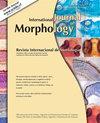Radiologıcal Evaluation of Volar Cortical Angle in the Anatolian Population
IF 0.5
4区 医学
Q4 ANATOMY & MORPHOLOGY
引用次数: 0
Abstract
Distal radius fractures are the most common fractures of the upper limb. The most commonly used method in the repair of these fractures is volar locking plates. Recently, the frequency of removal of volar locking plates after surgery has increased. There are many factors in its reduction. Anatomically, incompatibility of the distal end of the radius with volar locking plates is one of them. In previous studies, different volar cortical angle (VCA) values were found in other races. For this reason, this study aimed to determine the mean values by making VCA measurements of the Anatolian population. The study was designed retrospectively. In the study, measurements were made on computed tomography (CT) images of the distal end of the radius of 53 men and 28 women. Radial width, intermediate volar angle, and radial volar angle were measured in the images. On average, the radius width was 23.35±1.96 mm, and the intermediate volar angle was 26.02±.3.83°, radial volar angle was 24±3.07°. Radial width, intermediate volar angle, and radial volar angle differed significantly by gender (p<0.001). A significant correlation was found between radius width, intermediate volar angle, and radial volar angle values (p<0.001). It has been determined that the Anatolian population has a different VCA value than the European, Asian, and other populations. When using volar locking plates in distal radius fracture surgery, volar locking plates should be selected by considering the average values of the races.安那托利亚人群掌侧皮质角的影像学评价
桡骨远端骨折是上肢最常见的骨折。这类骨折最常用的治疗方法是掌侧锁定钢板。最近,手术后掌侧锁定钢板取出的频率有所增加。它的减少有很多因素。解剖上,桡骨远端与掌侧锁定钢板不相容是其中之一。在以往的研究中,其他种族的掌侧皮质角(VCA)值不同。因此,本研究旨在通过对安纳托利亚人口进行VCA测量来确定平均值。本研究采用回顾性设计。在这项研究中,对53名男性和28名女性的桡骨远端进行了计算机断层扫描(CT)成像。测量图像的径向宽度、中间掌角和径向掌角。平均半径宽度23.35±1.96 mm,中间掌侧角26.02±.3.83°,桡骨掌侧角24±3.07°。径向宽度、中间掌角和径向掌角在性别上差异显著(p<0.001)。桡骨宽度、中间掌角和桡骨掌角值之间存在显著相关性(p<0.001)。已经确定安纳托利亚人口的VCA值与欧洲、亚洲和其他人口不同。在桡骨远端骨折手术中使用掌侧锁定钢板时,应考虑椎体的平均值来选择掌侧锁定钢板。
本文章由计算机程序翻译,如有差异,请以英文原文为准。
求助全文
约1分钟内获得全文
求助全文
来源期刊

International Journal of Morphology
ANATOMY & MORPHOLOGY-
CiteScore
0.90
自引率
20.00%
发文量
110
审稿时长
3-8 weeks
期刊介绍:
The International Journal of Morphology (Revista Internacional de Morfología) (Print ISSN 0717-9367; Online ISSN 0717-9502) is an official publication of the Chilean Society of Anatomy, Argentine Association of Anatomy and Panamerican Association of Anatomy. It is the continuation of Revista Chilena de Anatomía (Chilean Anatomical Journal) and is published bimonthly. The six issues published yearly constitute one volume. This journal covers morphology in all its aspects, Gross Anatomy, Histology and Developmental Biology, as well as human and animals morphological aspects, including Celular, Molecular, systems or Evolutionary Biology. Reviews, short and brief communications and Letters to the Editor are also accepted.
 求助内容:
求助内容: 应助结果提醒方式:
应助结果提醒方式:


